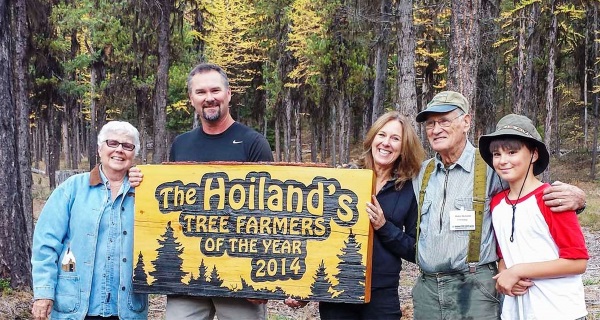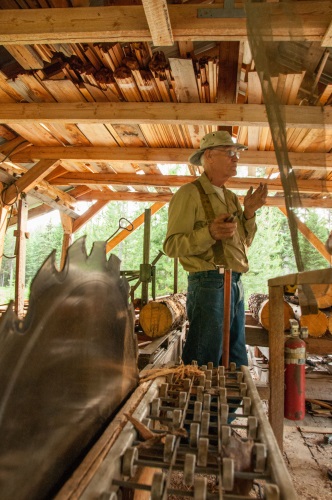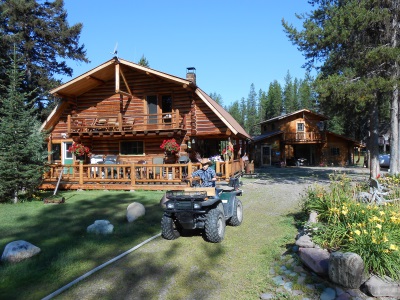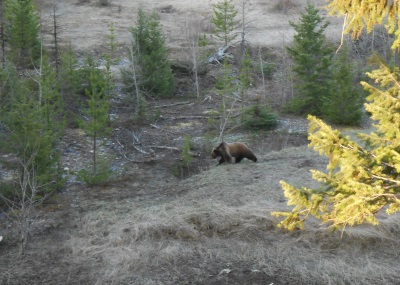Regional Outstanding Tree Farmers of the Year: Duke and Naomi Hoiland of Montana

What makes them outstanding?
ďWhere you canít tell work from play.Ē That is the motto of the Hoiland Family Tree Farm, just a few miles south of the Canadian border in the North Fork of the Flathead River Valley. While the property has been in the family since 1945, Duke and Naomi have been the stewards of this unique and spectacular Montana Tree Farm since 1967. Bordering the Flathead National Forest and a short distance from Glacier National Park, this land is living proof that active management can be done in complete harmony with critical wildlife habitat, unmatched scenic beauty, and responsible fire hazard mitigation while raising a family and entertaining friends.
Duke and Naomi are stalwart proponents of the Tree Farm program. Whether it is demonstrating their Mickey Mouse sawmill, touring the Hazardous Fuels reduction project or just sharing a cup of coffee, no one leaves without knowing about the Tree Farm program and how it has helped the Hoilands in meeting their land management goals. You are just as likely to see Duke at a State Legislature hearing, standing up for the benefits of active management and forest stewardship on all ownerships or wielding a chainsaw helping a neighbor learn to thin his forest. Their passion for Tree Farm is also being passed on to the next generations. When you see the grown children and grandchildren of the Hoilandís getting their hands dirty thinning trees or piling brush you canít help but wonder now was that work or play?
Tree Farmer Story
 When Naomi Hoilandís
Grandmother purchased the original 150 acres in the North Fork of the Flathead
River valley in 1945, it is doubtful she ever envisioned the property still
being in the family 70 years later, let alone the transformation from the
undeveloped, wild land to the well managed homestead that is now the Hoiland Tree
Farm. With the motto of where you canít
tell work from play, nearly everything on the present-day Tree Farm - from the
hand-hewed log home to the well-tended Firewise green zone to the hand built
walking bridge over Trail Creek - has come from the land and the blood, sweat
and tears of Duke, Naomi, family and friends! These are hands on Tree Farmers!
When Naomi Hoilandís
Grandmother purchased the original 150 acres in the North Fork of the Flathead
River valley in 1945, it is doubtful she ever envisioned the property still
being in the family 70 years later, let alone the transformation from the
undeveloped, wild land to the well managed homestead that is now the Hoiland Tree
Farm. With the motto of where you canít
tell work from play, nearly everything on the present-day Tree Farm - from the
hand-hewed log home to the well-tended Firewise green zone to the hand built
walking bridge over Trail Creek - has come from the land and the blood, sweat
and tears of Duke, Naomi, family and friends! These are hands on Tree Farmers!
With a driving goal in all of their land management activities being To pass the property on to the next generation in better condition than was received, Duke and Naomi have done a great job of building value within their family in the Tree Farm. The Hoiland property is important to all in the family parents, sons Tom and John, daughter Juli, and multiple grandchildren. They have truly lived for their forest, have used all parts of it, have made it a primary part of the life of their family, and shared it willingly with others. The younger generations are well prepared and eager to carry on the stewardship of the Hoiland Tree Farm. Axes, chainsaws and work gloves are common birthday presents in this family!
Naomi grew up in the Flathead Valley and spent time on the Trail Creek property from an early age. Duke grew up in Rose Lake, Idaho, and worked logging jobs in the Coeur díAlene mountains, down in the Floodwood Country in the St. Joe, and over the Divide in the Clearwater watershed. He has loads of stories to tell about logging camps, cutting large old growth western white pine, and fighting forest fires. While both had careers as educators in Spokane, Washington, summers were spent up the North Fork. When they both were finally retired in 1993, the North Fork became their year-round home.
Driven by the desire to do
the right thing to the best of their ability when managing their property, the
Hoilands participated in one of the very first Forest Stewardship classes
offered in Montana in 1993. They inventoried their land and wrote a management
plan. Newly armed with a vision and well-stated goals, they continued their
land-tending activities. They joined the Tree Farm program in 1997 and have
never looked back. Both Duke and Naomi have an insatiable appetite for learning
and information, and have attended numerous courses, conferences and Forestry
Mini-Colleges since 1993.
Duke used trees from the property to build their cabin in the late 1970ís and set up the Mickey Mouse Sawmill in 1979 (the primary product is sawdust, one byproduct is boards) to mill lumber for himself and his neighbors. The majority of the wood products resulting from management activities have been used on site, either milled into lumber to build the Carriage House and shop or as fuel-wood to warm the home through the long North Fork winter. Nothing goes to waste.
Duke and Naomi survived the Wedge Canyon Fire in 2003 as the fire burned past their property to the south. Their well prepared and defended property was quickly identified by the incident management team as a safety zone from which fire suppression activities could be based. They hosted incident personnel and provided a staging area for incident resources with a fill site for small engines. They were even ready to respond with a water wagon or ATVís as necessary. Although it was one of the most terrifying experiences in their tenure on the property, seeing their preparation pay off further steeled their resolve to share information and skills with neighbors, touting the benefits of active management.
Duke completed a hazardous fuels project on their property south of Trail Creek in 2005. Duke also completed a similar project along Trail Creek Road in 2013 to provide better ingress and egress for his neighbors and emergency responders in the event of the next large fire in the Trail Creek drainage. This treatment is frequently used as a showcase for other landowners and motivation for treatment on adjoining properties.
At 81 years old, Duke is
still an excellent sawyer, and is more than willing to assist neighbors by
falling difficult trees. Duke
volunteered his skills as a faller to do the majority of the falling on the
Hazardous Fuels Project at Sondreson Community Hall in May of 2014, and donated
the use of his 4 wheeler to do most of the skidding. For his efforts he was presented a new
Carhart Hickory Shirt. As lifelong
educators of youth, Duke and Naomi never miss an opportunity to share the
wonders of their Tree Farm with friends, family and strangers alike. Duke and
Naomi are constantly extolling the benefits  of Forest Stewardship and have
encouraged multiple neighbors to learn more about their forestlands and become
active stewards. The Tree Farm is a shining example that others want to follow.
of Forest Stewardship and have
encouraged multiple neighbors to learn more about their forestlands and become
active stewards. The Tree Farm is a shining example that others want to follow.
The Hoilands have worked hard not only to preserve the physical evidence of the historic Salish and Kootenai Indian Trail in the Trail Creek drainage, but also the history and stories associated with the route. The Hoilands host annual tours of the trail both on and off their property. Duke is one of few in the area who know its full extent and history.
The Hoilands exhibit both exemplary forest management and are active in promoting the Tree Farm program. Teaching through example, motivating others and passing the values of forestland and its management on to the next generation are among their greatest accomplishments. Even if the Tree Farm program did not exist, the Hoiland property would still be a shining example of the concept of stewardship.
Wood
Due to long distance to markets, the Hoilands chose to utilize the wood produced from management activities mostly on the property to improve the Tree Farm. Between the lumber milled on site, very hungry wood stoves and long winters, there seems to be no shortage of uses for the fiber grown! Commercial timber harvest began in 1976 in response to a Mountain Pine Beetle outbreak. Much of the larger LPP was harvested in a salvage operation and sold for house logs and sawlogs.
The Hoilands are known for their innovation and inventiveness, always in search of the better mousetrap! When presented with the challenge of managing his property on the other side of the creek, with no bridge he developed a unique solution. Built by son John and known as the Dinky Donkey yarder, they improvised a running skyline to swing logs across the creek. The skyline was also used to swing a 4 wheeler across the creek to yard logs to a landing to be swung back across the creek.
Natural regeneration is encouraged across the property focusing on the small disturbed areas created by burn piles. Some scarification is done through management activities. Precommercial thinning is ongoing in the understory and small openings created by past management activities.
Lumber from the Mickey Mouse sawmill has been used not only in buildings on their property, but Duke also donated lumber and labor to build the woodshed at the Community Hall. A load of Mickey Mouse lumber was sent to son Tom for his woodshop class who converted the donated lumber into numerous wooden toys which were then donated to Toys for Tots.
From a timber perspective, the Hoilands are succeeding in their goal, to pass the property on to the next generation in better condition than was received.
Water
Protection of water quality and assurance of water availability are key objectives for management of the tree farm. Trail Creek bisects the property for over ľ mile. Trail Creek is an important spawning stream for the endangered bull trout as well as supporting native cutthroat trout populations. While fishing is prohibited on the stream to protect the fisheries, the Hoilands enjoy seeing the large bull trout migrating up the stream to spawn.
Duke and Naomi are very sensitive to the protection of water quality and riparian habitat. They have pruned spruce trees and removed encroaching conifers to help promote establishment of red osier dogwood, willow, and other riparian vegetation to help bolster the native riparian vegetation communities. They closely monitor wildlife use and patterns and document sightings and impacts to vegetation of various wildlife uses. They have noted an interesting inverse relationship between local moose populations and the size and density of riparian vegetation. The Hoilands implement BMPís for water quality on their road and trail systems and strictly adhere to the Montana streamside management law.
Managing for water availability specifically for fire protection is a high priority. They have developed a robust system for remotely drafting water from Trail Creek during emergencies for protection of structures on site and as a fill site for local fire fighting needs, with no impact to the riparian zone.
To create a foot bridge across Trail Creek in 2003 for fire access during the Wedge Canyon Fire, Duke first felled a large spruce tree and limbed it. Then using a long line, pulleys for suspension, and a winch, Duke skidded it into place on log abutments. This provided a safe crossing for firefighting crews to access the fire on a daily basis with very minimal disturbance to the riparian zone.
Wildlife
Improving wildlife habitat for all species is another objective of the management plan, and this property has incredibly diverse wildlife use. Every large predator including black and grizzly bear, grey wolf, mountain lion, Canada lynx, bobcat, fox and coyote can be seen in any one year on the property. The riparian habitat is used by raptors including bald eagles and multiple species of hawks. Harlequin ducks have been sighted in the creek. Montana Fish Wildlife and Parks use the property to release relocated wildlife and conduct monitoring studies. White-tailed deer, elk and moose frequent the property which provides great viewing opportunity. The Hoilands have done an outstanding job in developing a lifestyle that has them living in harmony with all these wildlife species.
Vegetation management is well planned to provide the broadest range of habitats and provide adequate security. Maintaining hiding cover along the open roads is an important consideration to protect wildlife from drive by shootings. The Hoilands are aggressive in locating and treating noxious weeds through pulling and appropriate chemical treatments in compliance with label directions targeting specific plants. In addition, they have been very effective in teaching others to identify noxious weed species, and encouraging them to use appropriate treatments on their own property.
The property has remnant old growth Western Larch and Douglas-fir trees. Management around these trees is aimed at protecting them from fire and insect and disease activity. The Hoilands put out over 700 pheromone bubble caps on Douglas-fir trees up and down Trail Creek to help combat Douglas-fir bark beetle in 2004 after the Canyon Wedge Fire. The treatment was very successful, especially in comparison to untreated areas in other parts of the North Fork. Retaining these large trees is important to migrating song birds, and a variety of wood peckers and mammals.
Recreation
The Hoiland Tree Farm has been host to more than one vacationing family 'from away'. Not only is the property a great example of the beauty of Montana, but the education guests get while visiting goes a long way in spreading the word about stewardship forestry.
Recreational uses range from brief swimming excursions on the hottest summer days in frigid Trail Creek to wildlife viewing, target shooting, hiking, photography, berry picking, four-wheeling, snowmobiling, snowshoeing and hunting. The property serves as a training ground for remarkable hunting dogs and a place for grandkids to get dirty. As the grandkids expressed interest in wooden toys, Duke would help them fashion the toy starting with a blank cut from a log at the sawmill, finishing with his antique wood-working tools. Not only did this show them that not all toys come off the shelf at the store, but was that work, or was that play?
An historic trail used by Salish and Kootenai peoples and early settlers alike crosses the property, linking buffalo hunting grounds in eastern Montana with fishing and summer foraging areas in western Montana and Idaho. The Hoilands host annual tours for various agencies, schools, history buffs and other interested parties, giving guided tours of sections of the trail and sharing the history and stories of the trail. In recent years youth crews from the Montana Conservation Corps have come to hear the story of the historic trail and help to maintain it, guided by Duke.
Sitting around the firepit or spending a night in the authentic teepee are the perfect settings to share stories and history while building family ties to the land.


